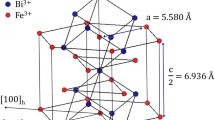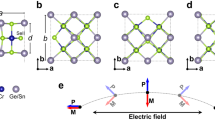Abstract
In this paper we present an analysis of the magnetic toroidal moment and its relation to the various structural modes in R3c-distorted perovskites with magnetic cations on either the perovskite A or B site. We evaluate the toroidal moment in the limit of localized magnetic moments and show that the full magnetic symmetry can be taken into account by considering small induced magnetic moments on the oxygen sites. Our results give a transparent picture of the possible coupling between magnetization, electric polarization, and toroidal moment, thereby highlighting the different roles played by the various structural distortions in multiferroic BiFeO3 and in the recently discussed isostructural material FeTiO3, which has been predicted to exhibit electric field-induced magnetization switching.
Similar content being viewed by others
References
H. Schmid, in Magnetoelectric interaction phenomena in crystals, edited by M. Fiebig, V. Eremenko, I.E. Chupis, (Kluwer, Dordrecht, 2004), pp. 1–34
B.B. Van Aken, J.P. Rivera, H. Schmid, M. Fiebig, Nature, 449, 702 (2007)
K.M. Rabe, Nature 449, 674 2007
C. Ederer, N.A. Spaldin, Phys. Rev. B 76, 214404 (2007)
N.A. Spaldin, M. Fiebig, M. Mostovoy, J. Phys.: Condens. Matter 20, 434203 (2008)
V.M. Dubovik, V.V. Tugushev, Phys. Rep. 4, 145 (1990)
D.G. Sannikov, J. Exp. Theo. Phys. 84, 293 (1997)
H. Schmid, Ferroelectrics 252, 41 (2001)
A.A. Gorbatsevich, Yu.V. Kopaev, V.V. Tugushev, Sov. Phys. JETP 58, 643 (1983)
N.A. Spaldin, M. Fiebig, Science 309, 391 (2005)
W. Eerenstein, N.D. Mathur, J.F. Scott, Nature 442, 759 (2006)
S.-W. Cheong, M. Mostovoy, Nature Materials 6, 13 (2007)
R. Ramesh, N.A. Spaldin, Nature Materials 6, 21 (2007)
C.J. Fennie, Phys. Rev. Lett. 100, 167203 (2008)
C. Ederer, C.J. Fennie, J. Phys.: Condens. Matter 20, 434219 (2008)
C. Ederer, N.A. Spaldin, Phys. Rev. B 71, 060401(R) (2005)
I.E. Dzyaloshinskii, Sov. Phys. JETP 5, 1259 (1957)
T. Moriya, Phys. Rev. 120, 91 (1960)
W. Eerenstein, F.D. Morrison, J. Dho, M.G. Blamire, J.F. Scott, N. Mathur, Science 307, 1203a (2005)
H. Bea, M. Bibes, S. Petit, J. Kreisel, A. Barthelemy, Philos. Mag. Lett. 87, 165 (2007)
I. Sosnowska, T. Peterlin-Neumaier, E. Streichele, J. Phys. C 15, 4835 (1982)
R.D. King-Smith, D. Vanderbilt, Phys. Rev. B 47, R1651 (1993)
R. Resta, Rev. Mod. Phys. 66, 899 (1994)
C.D. Batista, G. Ortiz, A.A. Aligia, Phys. Rev. Lett. 101, 077203 (2008)
Depending on the amount of distortion, the corresponding structure is sometimes referred to as the “ferroelectric LiNbO3 structure”. This distinction between distorted perovskite and LiNbO3 structure is purely quantitative and thus not relevant in the present context.
C. Michel, J.-M. Moreau, G.D. Achenbach, R. Gerson, W.J. James, Solid State Commun. 7, 701 (1969)
F. Kubel, H. Schmid, Acta Crystallogr. Sect. B 46, 698 (1990)
J. Ko, C.T. Prewitt, Phys. Chem. Miner. 15, 355 (1988)
L.C. Ming, Y.-H. Kim, Y. Uchida, Y. Wang, M. Rivers, Am. Mineral. 91, 120 (2006)
Ph. Ghosez, J.-P. Michenaud, X. Gonze, Phys. Rev. B 58, 6224 (1998)
R. de Souza, J.E. Moore, PRL 102, 249701 (2009)
C.J. Fennie, PRL 102, 249702 (2009)
D.L. Fox, J.F. Scott, J. Phys. C 10, L329 (1977)
R.R. Birss, Symmetry and Magnetism (North Holland Pub., Amsterdam, 1966)
Author information
Authors and Affiliations
Corresponding author
Rights and permissions
About this article
Cite this article
Ederer, C. Toroidal moments as indicator for magneto-electric coupling: the case of BiFeO3 versus FeTiO3 . Eur. Phys. J. B 71, 349–354 (2009). https://doi.org/10.1140/epjb/e2009-00274-4
Received:
Revised:
Published:
Issue Date:
DOI: https://doi.org/10.1140/epjb/e2009-00274-4




